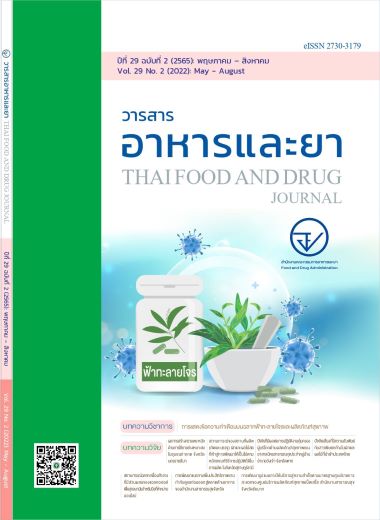สถานการณ์ฉลากเครื่องสำอางที่มีส่วนผสมของแอลกอฮอล์เพื่อสุขอนามัยสำหรับมือที่จำหน่ายออนไลน์
Main Article Content
บทคัดย่อ
ความสำคัญ: จากสถานการณ์การระบาดของโควิด-19 ทำให้มีผลิตภัณฑ์ทำความสะอาดฆ่าเชื้อจำหน่ายแพร่หลาย และมีการขายออนไลน์ซึ่งอาจมีฉลากที่ไม่ถูกต้องตามข้อกำหนดของกฎหมายในประเทศไทย
วัตถุประสงค์: เพื่อสำรวจสถานการณ์ฉลากเครื่องสำอางที่มีส่วนผสมของแอลกอฮอล์เพื่อสุขอนามัยสำหรับมือในรูปแบบเจลที่จำหน่ายออนไลน์
วิธีการวิจัย: เป็นการสำรวจแบบภาคตัดขวาง ช่วงเดือนเมษายนถึงกันยายน 2563 กลุ่มตัวอย่างคือเครื่องสำอางเจลที่มีส่วนผสมของแอลกอฮอล์เพื่อสุขอนามัยสำหรับมือที่สำรวจจากตลาดออนไลน์ในประเทศไทย จำนวน 192 ตัวอย่าง
ผลการศึกษา: จากการสำรวจฉลากกลุ่มตัวอย่างผลิตภัณฑ์เจลที่มีส่วนผสมของแอลกอฮอล์เพื่อสุขอนามัยสำหรับมือ พบว่ามีผลิตภัณฑ์ที่สอดคล้องตามข้อกำหนดของพระราชบัญญัติเครื่องสำอาง พ.ศ. 2558 ทุกหัวข้อ ร้อยละ 65.6 โดยพบว่ามีการแสดงชื่อเครื่องสำอาง และชื่อการค้าเป็นภาษาไทยถูกต้องร้อยละ 81.5 และ 89.6 ตามลำดับ ส่วนใหญ่แสดงตัวอักษรขนาดใหญ่ ร้อยละ 86.0 และ 83.4 ตามลำดับ สำหรับข้อมูลส่วนประกอบนั้น พบว่า กลุ่มตัวอย่างมีข้อมูลทุกหัวข้อถูกต้องร้อยละ 65.6 โดยทุกผลิตภัณฑ์มีการแสดงข้อมูลในหัวข้อประเภทเครื่องสำอาง ส่วนประกอบ ปริมาณสุทธิ และเลขที่ใบจดแจ้ง ร้อยละ 100 ขณะเดียวกันพบประเด็นแสดงข้อมูลส่วนประกอบไม่ถูกต้องตามกฎหมายมากที่สุดได้แก่ ไม่มีคำเตือนบนฉลาก ร้อยละ 23.9 รองลงมา ไม่มีครั้งที่ผลิต วิธีใช้ ที่ตั้งของสถานที่ผลิต เดือนปีที่ผลิต และเดือนปีที่หมดอายุ ร้อยละ 5.2, 3.2, 3.2, 1.6 และ 2.6 ตามลำดับ เมื่อพิจารณาถึงรายละเอียดของข้อมูลส่วนประกอบสำคัญในผลิตภัณฑ์พบว่า กลุ่มตัวอย่างร้อยละ 100.0 มีการแสดงข้อมูลรายละเอียดส่วนประกอบตามกฎหมายกำหนดทุกหัวข้อ สำหรับรายละเอียดข้อความที่แสดงบนฉลากที่ถูกต้องพบว่า ร้อยละ 100 ไม่มีการแสดงชื่อ/ส่วนประกอบ/อัตราส่วน/ปริมาณหรือสรรพคุณเครื่องสำอางเป็นเท็จ ไม่มีข้อความที่ทำให้เข้าใจว่ามีวัตถุตามข้อความ ชื่อ รูป รูปภาพ รอยประดิษฐ์ เครื่องหมายหรือเครื่องหมายการค้าดังกล่าวผสมอยู่โดยที่ไม่มีวัตถุนั้นผสมอยู่ ไม่มีคำพ้องเสียง พ้องรูป กับคำหรือข้อความที่สื่อถึงคุณประโยชน์ คุณภาพ สรรพคุณอันเป็นการโอ้อวดหรือเกินจริง และไม่มีข้อความที่ขัดกับวัฒนธรรมและศีลธรรมอันดีงามของไทยก่อให้เกิดความขัดแย้งหรือผลกระทบในเชิงลบทั้งทางตรงหรือทางอ้อมต่อสังคมวัฒนธรรม ศีลธรรม ประเพณี หรือพฤติกรรมที่เกี่ยวกับเพศ ภาษา และความรุนแรง รองลงมาได้แก่ ไม่มีข้อความที่ก่อให้เกิดความเข้าใจผิด ร้อยละ 99.5 มีข้อมูลความเข้มข้นของแอลกอฮอล์มากกว่า 70% v/v ร้อยละ 75.0 ลดการสะสมแบคทีเรีย ร้อยละ 50.0 ปัญหาสำคัญที่พบได้แก่ การไม่ระบุความเข้มข้น ร้อยละ 25.0 มีข้อความลดการสะสมแบคทีเรีย ร้อยละ 50.0 มีการแสดงข้อความระบุชื่อโรค ร้อยละ 13.5
สรุป: เครื่องสำอางที่มีส่วนผสมของแอลกอฮอล์เพื่อสุขอนามัยสำหรับมือในรูปแบบเจลที่จำหน่ายออนไลน์ในประเทศไทย มีความถูกต้องตามข้อกำหนดของกฎหมาย ร้อยละ 65.6 หรือ 2 ใน 3 ของการสำรวจตัวอย่างประเด็นปัญหาสำคัญที่ไม่สอดคล้องตามข้อกำหนดของกฎหมาย คือ ไม่ระบุความเข้มข้นของแอลกอฮอล์ ไม่แสดงชื่อการค้าและชื่อเครื่องสำอางภาษาไทย และมีการแสดงข้อความระบุชื่อโรค
Article Details

อนุญาตภายใต้เงื่อนไข Creative Commons Attribution 4.0 International License.
เอกสารอ้างอิง
รัชดา โตอนันต์, ธนศักดิ์ ประเสริฐสาร. โควิด-19 โคโรนาไวรัส สงครามที่มองไม่เห็น. วารสารอาหารและยา 2563;27(2):4-12.
มติชนออนไลน์. เหตุ-ผล “โควิด-19” แนวโน้มระบาดในไทย ระยะที่ 3 [อินเทอร์เน็ต]. กรุงเทพฯ: มติชนออนไลน์; 2563 [เข้าถึงเมื่อ 20 มี.ค. 2563]. เข้าถึงได้จาก
https://www.matichon.co.th/local/quality-life/news_2048105
กระทรวงสาธารณสุข. ประกาศกระทรวงสาธารณสุข เรื่อง ผลิตภัณฑ์ที่มีแอลกอฮอล์เป็นส่วนประกอบเพื่อสุขอนามัยสำหรับมือ พ.ศ. 2562. ราชกิจจานุเบกษา เล่มที่ 136, ตอนพิเศษ 230ง (ลงวันที่ 13 กันยายน 2562).
กระทรวงสาธารณสุข. ประกาศกระทรวงสาธารณสุข เรื่อง ยกเลิกประกาศกระทรวงสาธารณสุข เรื่อง ผลิตภัณฑ์ที่มีแอลกอฮอล์เป็นส่วนประกอบเพื่อสุขอนามัยสำหรับมือ พ.ศ. 2562. ราชกิจจานุเบกษา เล่มที่ 137, ตอนพิเศษ 54ง (ลงวันที่ 9 มีนาคม พ.ศ. 2563).
กระทรวงสาธารณสุข. ประกาศกระทรวงสาธารณสุข เรื่อง กำหนดลักษณะของเครื่องสำอางที่มีส่วนผสมของแอลกอฮอล์เพื่อสุขอนามัยสำหรับมือ ที่ห้ามผลิต นำเข้า หรือขาย พ.ศ. 2563. ราชกิจจานุเบกษา เล่มที่ 137, ตอนพิเศษ 54ง (ลงวันที่ 9 มีนาคม 2563).
ประกาศสำนักงานคณะกรรมการอาหารและยา เรื่อง การผลิตผลิตภัณฑ์ที่มีแอลกอฮอล์เป็นส่วนประกอบเพื่อสุขอนามัยสำหรับมือในสถานที่ผลิตยาแผนปัจจุบัน. (ลงวันที่ 5 มีนาคม 2563).
สำนักงานคณะกรรมการอาหารและยา. การขออนุมัติสถานที่ผลิตแอลกอฮอล์เพื่อสุขอนามัยสำหรับมือ (ตามเงื่อนไขกองยา/กองผลิตภัณฑ์สมุนไพร/กองควบคุมเครื่องมือแพทย์) เท่านั้น (ตั้งแต่วันที่ ๙ มีนาคม ๒๕๖๓ เป็นต้นไป) [อินเทอร์เน็ต]. นนทบุรี: สำนักงานคณะกรรมการอาหารและยา; 2563 [เข้าถึงเมื่อ 20 มี.ค. 2563]. เข้าถึงได้จาก:
https://www.fda.moph.go.th/sites/Cosmetic/Shared%20Documents/alcohol/alcohol.pdf
ประกาศคณะกรรมการเครื่องสำอาง เรื่อง ฉลากของเครื่องสำอางที่มีส่วนผสมของแอลกอฮอล์เพื่อสุขอนามัยสำหรับมือ พ.ศ. 2563. ราชกิจจานุเบกษา เล่มที่ 137, ตอนพิเศษ 305ง (ลงวันที่ 30 ธันวาคม 2563).
อภิษฐา ทรัพย์ประเสริฐ, จันทรรัตน์ สิทธิวรนันท์. การประเมินความคลาดเคลื่อนภายหลังออกสู่ตลาดของผลิตภัณฑ์เครื่องสำอางที่ได้รับการจดแจ้งโดยระบบการจดแจ้งอัตโนมัติ. วารสารอาหารและยา 2562; 26(1): 23-35.
เกษรา จันทรวงศ์ไพศาล, ชิดชนก เรือนก้อน. สถานการณ์การรับจดแจ้งเครื่องสำอางด้วยระบบ e-Submission และการกำกับดูแลของสำนักงานคณะกรรมการอาหารและยา ปีงบประมาณ พ.ศ. 2559-2562. วารสารอาหารและยา 2564;28(1):60-71.
รัตนาพร ฉัตรมงคล. กฎหมายคุ้มครองการซื้อเครื่องสำอางผ่านสื่อออนไลน์. วารสารกฎหมายสุขภาพและสาธารณสุข 2018;4(1):88-97.


